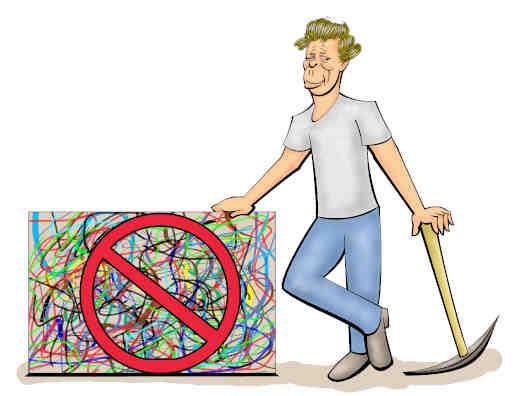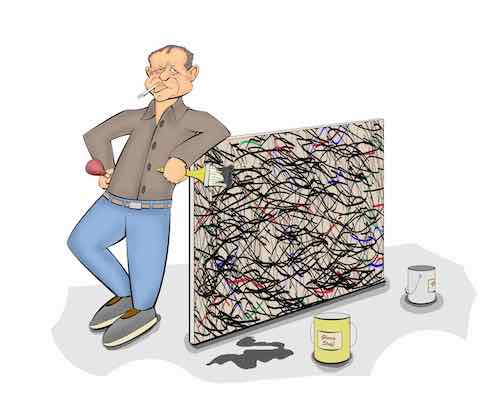Charles(

(Click to Zoom In and Out)
For those who have heard of Jackson Pollock but not his brother Charles, there is an ill-kept secret amongst the artistic cognoscenti. And that secret is:
 CHARLES POLLOCK
CHARLES POLLOCK
was a
 MUCH BETTER ARTIST
MUCH BETTER ARTIST
than
 JACKSON
JACKSON
!!!!!
But lest Jackson's fans go into spittle-flinging diatribes at this statement, they should realize what we actually mean is that:
 CHARLES POLLOCK
CHARLES POLLOCK
was a
 MUCH BETTER ARTIST
MUCH BETTER ARTIST
than
 JACKSON
JACKSON
from a
 TECHNICAL
TECHNICAL
STANDPOINT
!!!!!
In fact, Jackson himself acknowledged this. With regard to his now iconic "drip-action paintings", he once said, "Do you think I would have painted this CENSORED if I knew how to draw a hand?" Charles could indeed draw hands and do so very well.
Charles was Jackson's senior by 9 years. Born in Colorado in 1902, he and the family later moved to Los Angeles. Early on Charles showed he had talent and in his mid-20's he moved to New York to study with Thomas Hart Benton at the Art Student's League. Tom, for those who haven't heard of him, was famous for his "social realist" paintings and his murals.
If you look really hard you might find a book that defines the term. One that does states that "social realism" is an art style "referring in its narrow sense to paintings treating themes of social protest in a naturalistic or quasi-expressionist manner." Which may help the reader some.
Social realist paintings began appearing during the Great Depression of the 1930's. They depicted everyday vignettes in the lives of the working poor when the times were tough and 20% of the workforce was unemployed. This statistic, though, belies the severity of the effects of the Depression and some cities fared far worse. At one point, Cleveland numbered 50% unemployed, and in Toledo the high was 80%.
And it was Thomas Hart Benton who was the most famous of the social realists. His art, though, can't be called realistic as most people think of it. On the other hand it is more realistic than what the Expressionists like Edvard Munch and Elaine de Kooning were painting. Instead the figures in social realism might be better compared to those painted by the Renaissance Mannerists, of whom the most famous is Doménikos Theotokópoulos, better known to most as El Greco.1
Footnote
Social realist painting is not to be confused with socialist realism. Socialist realism was the art that was promoted by the Soviet Government from the early 1930's to the fall of the Soviet Union that began in 1988 and ended in the final collapse in 1991.
Unlike social realist art, the style of socialist realism was realistic in the traditional sense. Also the subject matter was not depicting the trials and hardships of the working people. Far from it. Instead it was for puffing up how great they had it. Socialist realism would depict healthy and stalwart workers happily pitching in for the good of the state. Of course, it wasn't fooling anybody; certainly not the citizens of the Soviet Union.
The Soviet governments support of socialist realism was in large measure a reaction of the government against the modern art movements. The real irony is that people in the USA who were (and are) rabidly anti-communist very often did (and do) express disdain for modern art in very similar terms as did the Soviet leaders.
OK. If Charles was the better artist, why does everyone know Jackson and not Charles?
The problem with Charles's art is he was too good. So it was worth his while to stick with the social realistic style that he learned from Tom. Also his art was similar to Tom's art both in style and theme. In fact, if you see one of Charles's paintings you might think it's a Thomas Hart Benton.
Then in the early 1940's Charles began moving into modern art such as cubism and abstract expressionism. Although the student might learn to recognize a Picasso or a Braque or it's not easy for the layman to pick out a De Koonig, and it's even harder to look at one of Charles's paintings and say, "Ah! A Charles Pollock!" Charles then was painting in styles that were largely created by other artists.

Jackson and his Paintings
Immediately Recognizable.
Not so with Jackson. Once he began his drip-action paintings, a Jackson Pollock was immediately recognizable. The style and method were so quickly tied in with Jackson that anyone else trying a drip-action painting was (and will be forevermore) labeled as a Jackson Pollock imitator.
So whether you think Jackson's paintings are the greatest art in the world (as some do) or are just macaroni decorations (as do others), his drip-action art is popular. At museums you'll see people breeze past a Kandinsky or a De Koonig, but they'll stop and stare at the lines, drips, and splatters laid down by Jackson. Oh, maybe not as many as gather around the Mona Lisa but certainly enough. Another helping factor is Jackson's paintings don't offend very many people. So you can put them up - or a least copies - in business offices just about anywhere. Certainly you're not not likely to see a copy of Gustave Corbet's L'Origine du monde hanging in a corporate board room.
Unlike Jackson, there's not any real biographies of Charles, and in addition to their paintings, the two brothers were also different in lifestyles. Jackson went through periods of self-doubt - during his life his work was by no means as popular and praised as it is today - which led to times of true clinical depression that required professional help. Jackson was also notoriously intemperate, and this bad habit ultimately led to his premature death in his mid-forties.
Charles, though, seems to have been more even keeled. He was also more mobile than his brother and lived in places as varied as Colorado, California, Washington, D. C., Detroit, Mexico, Rome, and Paris. More healthful habits led at least in part to a long and productive life.
Perhaps the biggest difference between Charles and Jackson is that, Charles was a professor. During the Depression he had begun working for the Federal Resettlement Administration and the Work Projects Administration, both of which were part of FDR's New Deal. As part of his RA and WPA work, Charles's painted murals and this took him up to Michigan and in 1942 he began teaching at Michigan State University. He remained on the faculty until 1968.
After a perusal of Charles's art, you might argue that Charles outstripped his teacher and that his social realist art is, well, more socially realistic than Tom's. Charles's drawings show considerable skill and if you look at his drawing of Jackson playing the banjo, you know that Charles could indeed draw hands.
References
"Social Realism - Painting", Encyclopedia Britannica.
"Unemployment During the Great Depression: Facts and Figures", Kiara Dawson, Business Upside, October 27, 2020.
"Charles Pollock: Modernism in the Making", Broad Museum, Michigan State University.
"Charles Pollock", Smithsonian American Art Museum.
"Charles Pollock. A Retrospective", Wall Street International Magazine, April 27, 2015.